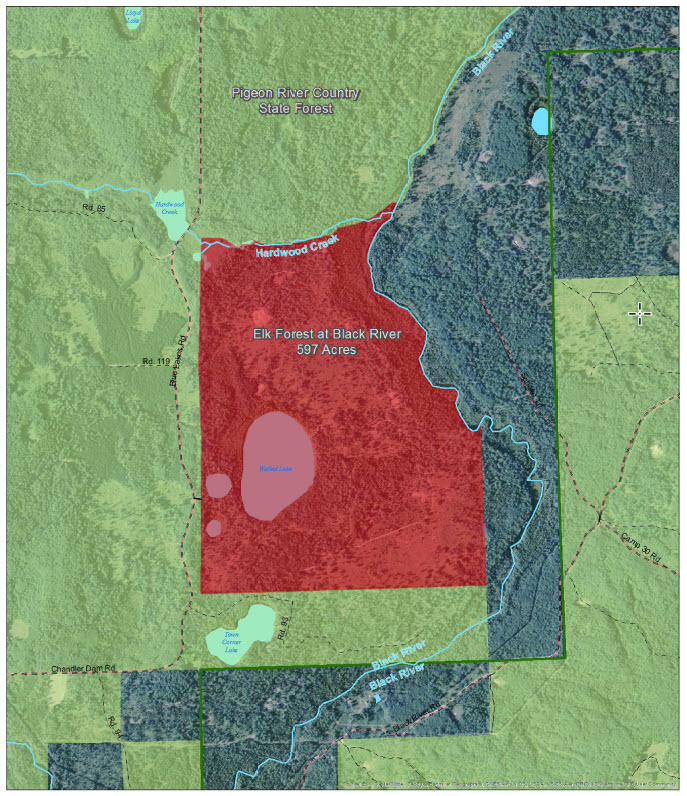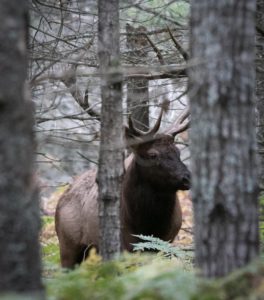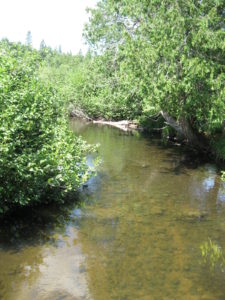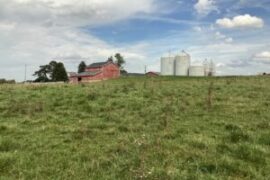Outdoor enthusiasts know that the rugged, 108,000-acre expanse of Michigan’s Pigeon River Country State Forest is one of the state’s premier destinations to connect with nature. Three world-class trout streams ramble through forests and wetlands at the heart of the state’s elk range.
What could be better than that? More of it.
A Department of Natural Resources land deal valued at more than $2 million finalized last month adds the Elk Forest at Black River, a stunning, 597-acre parcel in Montmorency County, to Michigan’s public lands. This ecologically important area is surrounded on three sides by existing state-managed land and will become part of the Pigeon River Country State Forest, known to many as “the Big Wild.”
“This spectacular place adds a gem to the crown of Michigan’s public lands,” said DNR Forest Resources Division Chief Debbie Begalle. “The land will be open for hiking, hunting, fishing, elk viewing, skiing, snowshoeing, bird watching, mushroom hunting and berry picking, to name just a few activities.”
The purchase provides public access to Walled Lake, a spring-fed, 44-acre double sinkhole lake. A smaller lake and pond are nearby. Adventurers also will enjoy the addition of more than a mile of the Black River, a top-quality trout stream, and a half-mile of Hardwood Creek.

This stretch of the Black River is supported by DNR Type 1 trout regulations where the minimum brook trout size limit is 7 inches, all tackle types are allowed, and the daily bag limit is five fish. Trout fishing season begins the last Saturday in April and ends Sept. 30. Walled Lake fishing regulations will be identical to those of neighboring South and North Blue lakes: catch and immediate release only, and artificial lures only.
Upland from the lake and river, a forest of mixed pine, aspen and oak is a thriving wildlife haven, and near the water, wetland plants such as wild cranberry and carnivorous pitcher plants grow beneath a canopy of cedar. The Black River’s cold waters make it the premier brook trout stream east of the Mississippi. It is the only river managed exclusively for native brook trout in the entire Lake Huron basin. The river also provides ideal habitat for the Hungerford’s crawling water beetle – a federally endangered, shield-shaped insect found in only a few areas around the Great Lakes. Some parts of the property are prime nesting areas for the tiny Kirtland’s warbler, a songbird that recently came off the federal Endangered Species List.
“This area is full of wildlife,” said Kerry Wieber, DNR forest land administrator. “It offers opportunities for hunters to pursue game species such as elk, white-tailed deer, black bear and ruffed grouse, as well as opportunities for wildlife watchers to catch a glimpse of nongame species such as red-shouldered hawk, loons and pine marten.”
This land deal conserves from development one of the biggest privately owned parcels in Michigan’s core elk range. That in turn protects the Cheboygan River watershed, a critical area for groundwater recharge. It also prevents groundwater contamination through the area’s “karst lakes;” the sinkholes that form the lakes and are directly connected to the groundwater beneath. The forest on the property will be dual-certified as sustainably managed by the Sustainable Forest Initiative and Forest Stewardship Council. This will ensure forest management that promotes biological diversity, health and habitat.

The purchase of the Elk Forest property adds another key chapter to the land’s already colorful history. Deep in the forest are the foundations to the hunting camp of George King, an early 20th-century fishing guide. King hosted authors Ernest Hemingway and William B. Mershon at the camp, where they fished for trout and hunted wild game. King is said to have sighted the last known wild passenger pigeon in the region (for which the Pigeon River Country is named) near the property. The pigeon went extinct in 1914 as a result of overhunting and habitat destruction.
 The $2,019,000 to purchase the property came from the Forest Legacy Program with matching funds from the DNR’s Land Exchange Facilitation Fund and a $75,000 donation from the Rocky Mountain Elk Foundation. The foundation was instrumental in ensuring that this property was acquired for the people of Michigan and that it will be managed sustainably for the health of the forest and wildlife. Forest Legacy funds are used to protect environmentally important forest areas from development and fragmentation.
The $2,019,000 to purchase the property came from the Forest Legacy Program with matching funds from the DNR’s Land Exchange Facilitation Fund and a $75,000 donation from the Rocky Mountain Elk Foundation. The foundation was instrumental in ensuring that this property was acquired for the people of Michigan and that it will be managed sustainably for the health of the forest and wildlife. Forest Legacy funds are used to protect environmentally important forest areas from development and fragmentation.
“Rocky Mountain Elk Foundation is pleased to collaborate on the strategic protection of important elk habitat within the Pigeon River Country State Forest.” said Blake Henning, the foundation’s chief conservation officer. “Our partnership with DNR and the staff’s efforts to acquire and maintain quality elk habitat means an increase in quality management and public access.”
The Elk Forest at Black River will be accessible from Blue Lakes Road on its west side. Motorized vehicle use at the Elk Forest property is limited until the DNR completes a road inventory and develops an access plan, with public input. Structures on the property will remain in private ownership through the end of May; the DNR urges everyone to respect the owner’s privacy until that time.
Explore Michigan’s largest connected block of natural land in the Lower Peninsula at Michigan.gov/PigeonRiverCountry.








